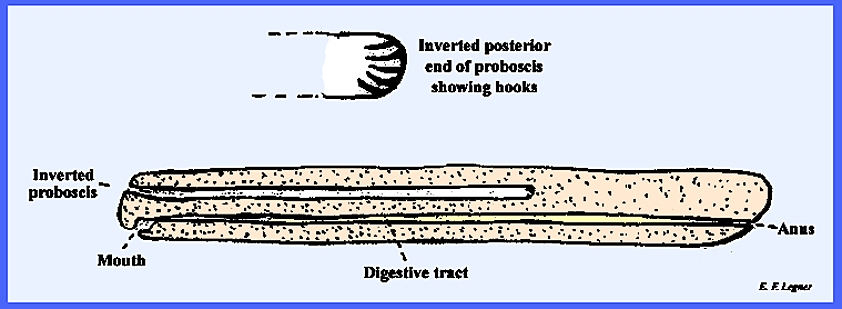File:
<nemertinea.htm> <Index to Invertebrates> <Bibliography> <Glossary> Site Description
<Navigate to Home>
|
Invertebrate
Zoology Kingdom: Animalia, Phylum: Nemertinea (Nemertera) (Contact)
CLICK on
underlined file names and included illustrations to enlarge: The Phylum Nemertinea
are long, worm-like animals that resemble flatworms in some respects. Their size varies from a few millimeters
to several meters. They are almost exclusively marine but some freshwater
forms exist and one occurs on damp land.
They are all unsegmented.
There is no body cavity other than the digestive tract (e.g., no coelom). They are sluggish movers in sand and mud. They have a large and fancy
eversible proboscis, which is not connected to the digestive tract. It is turned inside out food is being
gathered, and is used in piercing and entangling prey, which is then brought
back to the mouth. Two classes, Anopla and Enopla are
presented. In the Anopla the
mouth is located posterior to the brain, the central nervous system lies just
below the epidermis and the proboscis is unarmed. In the Enopla the
mouth is located anterior to the brain, the central nervous system is inside
the body wall muscles and the proboscis is frequently armed. The Digestive Tract is a straight
tube and this is the first animal that possesses an anus. Respiration
is by diffusion and there are no specialized structures. Excretion is accomplished with
flame cells. The Circulatory
System consists of closed
blood vessels. There is a dorsal
blood vessel and two lateral branches of it.
No heart is present and the movement of blood is accomplished in two
ways: (1) by contraction of the walls
of the vessels and (2) by movements of the animals themselves. There are red corpuscles in the vessels,
which is unusual because most invertebrates have haemoglobin dissolved
in the plasma. The haemoglobin
distributes oxygen and may also distribute food and wastes. The Nervous System
is the same as in the Turbellaria.
Sense Organs are found as eyes at the head end and olfactory
pit structures on the head. Sense cells make
the whole body surface sensitive. The Body Wall
is similar to that of Turbellaria. A
ciliated epidermis occurs that is supplied with numerous gland cells. There are well-developed circular and
longitudinal muscles in the mesenchyme. Reproduction
is both sexual and asexual. In sexual
reproduction there are mostly separate sexes. The gonads open to the surfaace by ducts, and fertilization is
external in the water. The following
diagram shows a typical life cycle: Asexual reproduction is by
fragmentation. Here the body breaks
up into many pieces, which are capable of regenerating to a new worm. This not only serves reproduction but is
also for protection of the animal as a whole. Importance.--
There is one parasite on the egg masses of the blue crab, but otherwise they
are not important economically.
However, from an academic point of view these are the lowest animals
with a complete digestive tract with a mouth and anus and they possess a
circulatory system with blood, corpuscles and haemoglobin. They also have a separate proboscis. ------------------------------------ Please see
following plate for Example Structures of the Nemertinea: Plate 63 = Phylum: Nemertinea -- Example
Structures ============== |

